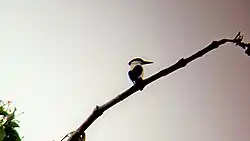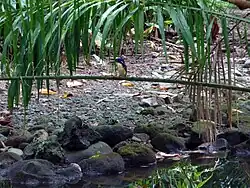List of Coraciiformes by population
| The population of birds |
|---|
 |
This is a list of Coraciiformes species by global population. While numbers are estimates, they have been made by the experts in their fields. For more information on how these estimates were ascertained, see Wikipedia's articles on population biology and population ecology.
This list is incomprehensive, as not all Coraciiformes have had their numbers quantified.
Species by global population
| Common name | Binomial name | Population | Status | Trend | Notes | Image |
|---|---|---|---|---|---|---|
| Niau kingfisher | Todiramphus gambieri | 100-150[1] | CR[1] | Endemic to Niau. Numbered 400 – 600 in 1974. Surveys in 2019 estimated 173 individuals in total.[1] | ||
| Kofiau paradise kingfisher | Tanysiptera ellioti | 350 – 1500[2] | NT[2] | It is difficult to estimate the population size of this species; however, the population is considered very unlikely to number fewer than 1,000 mature individuals.[2] | ||
| Moustached kingfisher | Actenoides bougainvillei | 1300-7000 (best estimate: 2500-5000)[3] | LC[3] |  | ||
| Mewing kingfisher | Todiramphus ruficollaris | 2100-3500 (best estimate: 2700)[4] | LC[4] | Previous surveys are considered likely to have underestimated the number of T. ruficollaris in secondary habitats due to their exclusion of agricultural habitat in their calculation. |  | |
| Marquesan kingfisher | Todiramphus godeffroyi | 350[5] | CR[5] | Numbered 695 in 2003. Numbered approximately 350 mature individuals in 2014.[5] | ||
| Azure dollarbird | Eurystomus azureus | 1,500-7,000[6] | NT[6] | Possibly up to 2,500-9,999 individuals based on an assessment of known records, descriptions of abundance and range size.[6] |  | |
| Keel-billed motmot | Electron carinatum | 1,500-7,000[7] | VU[7] |  | ||
| Scaly ground roller | Geobiastes squamiger | 1,500-7,000[8] | VU[8] |  | ||
| Short-legged ground roller | Brachypteracias leptosomus | 10,000-25,000[9] | VU[9] | |||
| White-mantled kingfisher | Todiramphus albonotatus | 2,500-9,999[10] | NT[10] |  | ||
| Bismarck kingfisher | Ceyx websteri | 2,500-9,999[11] | VU[11] |  | ||
| Hombron's kingfisher | Actenoides hombroni | 15,000[12] | LC[12] | The population size of this species is unknown. The population probably still numbers tens of thousands of individuals. |  | |
| Sombre kingfisher | Todiramphus funebris | 10,000-25,000 (best estimate: 15,000-25,000)[13] | LC[13] |  | ||
| Winchell's kingfisher | Todiramphus winchelli | 2,500-9,999[14] | VU[14] | .jpg) | ||
| Vanuatu kingfisher | Todiramphus farquhari | 14,000-94,000[15] | NT[15] |  | ||
| Blue-banded kingfisher | Alcedo euryzona | 50-249[16] | CR[16] | Difficult to estimate, but population size thought to be very small. |  | |
| Philippine dwarf kingfisher | Ceyx melanurus | 15,000 – 30,000[17] | LC[17] | While its population size is recorded as unknown, given its range covers nearly 80,000 km2, even if only a small percentage of this is occupied, the global population size is unlikely to be small. | .jpg) | |
| Blue-throated motmot | Aspatha gularis | 20,000-49,999[18] | LC[18] |  | ||
| Tody motmot | Hylomanes momotula | 20,000-49,999[19] | LC[19] |  | ||
| Long-tailed ground roller | Uratelornis chimaera | 9,487-32,687[20] | VU[20] |  | ||
| Russet-crowned motmot | Momotus mexicanus | 50,000-499,999[21] | LC[21] |  | ||
| Turquoise-browed motmot | Eumomota superciliosa | 500,000-4,999,999[22] | LC[22] |  | ||
| Amazon kingfisher | Chloroceryle amazona | 500,000-4,999,999[23] | LC[23] |  | ||
| American pygmy kingfisher | Chloroceryle aenea | 500,000-4,999,999[24] | LC[24] |  | ||
| Common kingfisher | Alcedo atthis | 716,000-1,760,000[25] | LC[25] |  | ||
| Rainbow bee-eater | Merops ornatus | 670,000[26] | LC[26] | Estimated to number at least 1 million individuals in 2008.[26] |  | |
| European bee-eater | Merops apiaster | 18,400,000-28,000,000[27] | LC[27] |  | ||
| Blue-crowned motmot | Momotus momota | 5,000,000 – 50,000,000[28] | LC[28] |
See also
References
- ^ a b c d BirdLife International. (2024). "Todiramphus gambieri". IUCN Red List of Threatened Species. 2024: e.T22683499A232219952. doi:10.2305/IUCN.UK.2024-2.RLTS.T22683499A232219952.en. Retrieved 29 July 2025.
- ^ a b c d BirdLife International. (2022). "Tanysiptera ellioti". IUCN Red List of Threatened Species. 2022: e.T22683582A209894634. doi:10.2305/IUCN.UK.2022-1.RLTS.T22683582A209894634.en. Retrieved 29 July 2025.
- ^ a b c BirdLife International. (2024) [errata version of 2022 assessment]. "Actenoides bougainvillei". IUCN Red List of Threatened Species. 2022: e.T22683519A265147933. doi:10.2305/IUCN.UK.2022-2.RLTS.T22683519A265147933.en. Retrieved 29 July 2025.
- ^ a b c BirdLife International. (2022). "Todiramphus ruficollaris". IUCN Red List of Threatened Species. 2022: e.T22683465A209393532. doi:10.2305/IUCN.UK.2022-1.RLTS.T22683465A209393532.en. Retrieved 29 July 2025.
- ^ a b c d BirdLife International. (2019). "Todiramphus godeffroyi". IUCN Red List of Threatened Species. 2019: e.T22683487A149519891. doi:10.2305/IUCN.UK.2019-3.RLTS.T22683487A149519891.en. Retrieved 29 July 2025.
- ^ a b c d BirdLife International. (2017). "Eurystomus azureus". IUCN Red List of Threatened Species. 2017: e.T22682926A117000326. doi:10.2305/IUCN.UK.2017-3.RLTS.T22682926A117000326.en. Retrieved 29 July 2025.
- ^ a b c BirdLife International. (2020). "Electron carinatum". IUCN Red List of Threatened Species. 2020: e.T22682989A179184295. doi:10.2305/IUCN.UK.2020-3.RLTS.T22682989A179184295.en. Retrieved 29 July 2025.
- ^ a b c BirdLife International. (2021). "Geobiastes squamiger". IUCN Red List of Threatened Species. 2021: e.T22682937A193850974. doi:10.2305/IUCN.UK.2021-3.RLTS.T22682937A193850974.en. Retrieved 29 July 2025.
- ^ a b c BirdLife International. (2023). "Brachypteracias leptosomus". IUCN Red List of Threatened Species. 2023: e.T22682931A232610024. doi:10.2305/IUCN.UK.2023-1.RLTS.T22682931A232610024.en. Retrieved 30 July 2025.
- ^ a b c BirdLife International. (2019). "Todiramphus albonotatus". IUCN Red List of Threatened Species. 2019: e.T22683328A156417787. doi:10.2305/IUCN.UK.2019-3.RLTS.T22683328A156417787.en. Retrieved 30 July 2025.
- ^ a b c BirdLife International. (2018). "Ceyx websteri". IUCN Red List of Threatened Species. 2018: e.T22683051A131912965. doi:10.2305/IUCN.UK.2018-2.RLTS.T22683051A131912965.en. Retrieved 30 July 2025.
- ^ a b c BirdLife International. (2024). "Actenoides hombroni". IUCN Red List of Threatened Species. 2024: e.T22683542A241691549. doi:10.2305/IUCN.UK.2024-2.RLTS.T22683542A241691549.en. Retrieved 30 July 2025.
- ^ a b c BirdLife International. (2022). "Todiramphus funebris". IUCN Red List of Threatened Species. 2022: e.T22683387A217398758. doi:10.2305/IUCN.UK.2022-2.RLTS.T22683387A217398758.en. Retrieved 30 July 2025.
- ^ a b c BirdLife International. (2016). "Todiramphus winchelli". IUCN Red List of Threatened Species. 2016: e.T22683291A92983266. doi:10.2305/IUCN.UK.2016-3.RLTS.T22683291A92983266.en. Retrieved 30 July 2025.
- ^ a b c BirdLife International. (2022). "Todiramphus farquhari". IUCN Red List of Threatened Species. 2022: e.T22683347A216002072. doi:10.2305/IUCN.UK.2022-2.RLTS.T22683347A216002072.en. Retrieved 30 July 2025.
- ^ a b c BirdLife International. (2024). "Alcedo euryzona". IUCN Red List of Threatened Species. 2024: e.T22726971A258586382. doi:10.2305/IUCN.UK.2024-2.RLTS.T22726971A258586382.en. Retrieved 30 July 2025.
- ^ a b c BirdLife International. (2024). "Ceyx melanurus". IUCN Red List of Threatened Species. 2024: e.T61655451A252381104. doi:10.2305/IUCN.UK.2024-2.RLTS.T61655451A252381104.en. Retrieved 30 July 2025.
- ^ a b c BirdLife International. (2020). "Aspatha gularis". IUCN Red List of Threatened Species. 2020: e.T22682983A152200542. doi:10.2305/IUCN.UK.2020-3.RLTS.T22682983A152200542.en. Retrieved 30 July 2025.
- ^ a b c BirdLife International. (2020). "Hylomanes momotula". IUCN Red List of Threatened Species. 2020: e.T22682980A152231624. doi:10.2305/IUCN.UK.2020-3.RLTS.T22682980A152231624.en. Retrieved 1 August 2025.
- ^ a b c BirdLife International. (2021). "Uratelornis chimaera". IUCN Red List of Threatened Species. 2021: e.T22682969A193044857. doi:10.2305/IUCN.UK.2021-3.RLTS.T22682969A193044857.en. Retrieved 1 August 2025.
- ^ a b c BirdLife International. (2020). "Momotus mexicanus". IUCN Red List of Threatened Species. 2020: e.T22683001A163627056. doi:10.2305/IUCN.UK.2020-3.RLTS.T22683001A163627056.en. Retrieved 1 August 2025.
- ^ a b c BirdLife International. (2020). "Eumomota superciliosa". IUCN Red List of Threatened Species. 2020: e.T22682992A163630124. doi:10.2305/IUCN.UK.2020-3.RLTS.T22682992A163630124.en. Retrieved 1 August 2025.
- ^ a b c BirdLife International. (2020). "Chloroceryle amazona". IUCN Red List of Threatened Species. 2020: e.T22683649A163588964. doi:10.2305/IUCN.UK.2020-3.RLTS.T22683649A163588964.en. Retrieved 1 August 2025.
- ^ a b c BirdLife International. (2020). "Chloroceryle aenea". IUCN Red List of Threatened Species. 2020: e.T22683658A163591832. doi:10.2305/IUCN.UK.2020-3.RLTS.T22683658A163591832.en. Retrieved 1 August 2025.
- ^ a b c BirdLife International. (2024). "Alcedo atthis". IUCN Red List of Threatened Species. 2024: e.T22683027A264589271. doi:10.2305/IUCN.UK.2024-2.RLTS.T22683027A264589271.en. Retrieved 1 August 2025.
- ^ a b c d BirdLife International. (2024). "Merops ornatus". IUCN Red List of Threatened Species. 2024: e.T22683753A263663726. doi:10.2305/IUCN.UK.2024-2.RLTS.T22683753A263663726.en. Retrieved 1 August 2025.
- ^ a b c BirdLife International. (2024). "Merops apiaster". IUCN Red List of Threatened Species. 2024: e.T22683756A264578444. doi:10.2305/IUCN.UK.2024-2.RLTS.T22683756A264578444.en. Retrieved 1 August 2025.
- ^ a b c BirdLife International. (2016). "Momotus momota". IUCN Red List of Threatened Species. 2016: e.T61634607A95173087. doi:10.2305/IUCN.UK.2016-3.RLTS.T61634607A95173087.en. Retrieved 1 August 2025.
